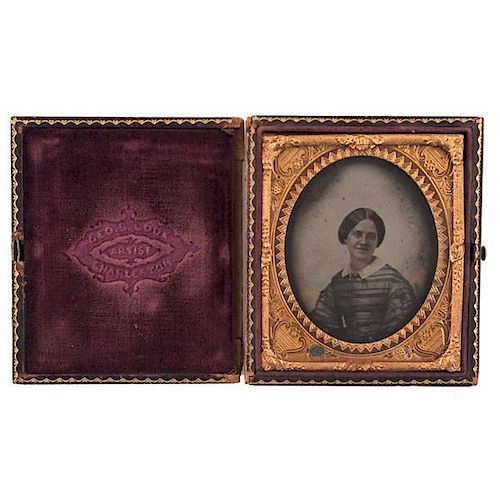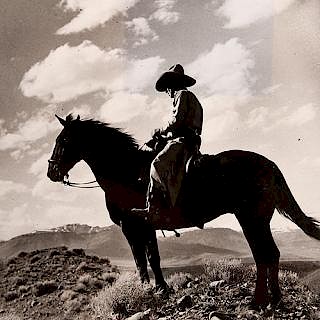Confederate Photographer, George S. Cook, Sixth Plate Ambrotype of Wife, Elizabeth Smith Francisco, Plus
About Seller
6270 Este Ave.
Cincinnati , OH 45232
United States
With offices in Cincinnati, Cleveland and Denver, Cowan’s holds over 40 auctions each year, with annual sales exceeding $16M. We reach buyers around the globe, and take pride in our reputation for integrity, customer service and great results. A full-service house, Cowan’s Auctions specializes in Am...Read more
Two ways to bid:
- Leave a max absentee bid and the platform will bid on your behalf up to your maximum bid during the live auction.
- Bid live during the auction and your bids will be submitted real-time to the auctioneer.
Bid Increments
| Price | Bid Increment |
|---|---|
| $0 | $25 |
| $500 | $50 |
| $1,000 | $100 |
| $2,000 | $250 |
| $5,000 | $500 |
| $10,000 | $1,000 |
| $20,000 | $2,500 |
| $50,000 | $5,000 |
| $100,000 | $10,000 |
About Auction
Jun 12, 2015 - Jun 13, 2015
Cowan's Auctions dawnie@cowans.com
- Lot Description
Sixth plate ambrotype of a young woman wearing a striped gown and gold tinted jewelry, housed in full leather, push-button case, with velvet mat stamped Geo. S. Cook/ Artist/ Charleston. Although the ambrotype lacks period identification, the woman has been tentatively identified as George Cook's wife, Elizabeth Smith Francisco, through a comparison with a known portrait of Cook, his wife Elizabeth, two of their children, and Elizabeth's niece, Lavinia Pratt, who would later marry Cook after the death of her aunt. The Cook family portrait is illustrated in Photographer...Under Fire: The Story of George S. Cook (1819-1902), by Jack Ramsay, Jr. (1994: p.29). A copy of Ramsay's book accompanies the lot.
Born in Stratford, CT, George S. Cook (1819-1902), studied painting in New Orleans at the time that photography was introduced in America in 1839. He immediately adopted the medium and established a gallery in New Orleans before setting out to teach photographic techniques to others in small, southern towns.
In 1846, Cook married Elizabeth Smith Francisco, a native of New Jersey. According to a family document referenced in Photographer...Under Fire, it was believed that Elizabeth was of "Portuguese origin," and a "descendant of 'a hero of the American Revolution...Peter Francisco'" (p.28). In the late 1840s, Cook settled in Charleston, SC, to raise a family with Elizabeth, and he became one of the principal Confederate photographers during the Civil War. He gained notoriety for recording the gradual deterioration of Fort Sumter and Charleston. In the fall of 1863, Elizabeth fell ill and became bedridden, subsequently passing away in April 1864. Two years later, in September 1866, Cook married Elizabeth's niece, Lavinia Pratt, who was 18 years younger than her husband. After moving his family to Richmond in 1880, Cook’s older son, George LaGrange Cook, took over the Charleston studio. Cook remained an active photographer throughout the remainder of his life, and after his death on November 27, 1902, his younger son Huestis Cook, who also had an interest in photography, took over the studio in Richmond.Some spotting along perimeter of ambrotype, where plate meets mat. Housed in full case completely separated along hinge, loss along top of case near hinge, significant wear to surface of case.Condition
- Shipping Info
-
SHIPPING. At the request of the buyer, Cowan's will authorize the shipment of purchased items. Shipments usually occur within two weeks after payment has been received. Shipment is generally made via UPS Ground service. Unless buyer gives special instructions, the shipping method shall be at the sole discretion of Cowan's Auctions, Inc.. Cowan's is in no way responsible for the acts or omissions of independent handlers, packers or shippers of purchased items or for any loss, damage or delay from the packing or shipping of any property.
-
- Buyer's Premium



 EUR
EUR CAD
CAD AUD
AUD GBP
GBP MXN
MXN HKD
HKD CNY
CNY MYR
MYR SEK
SEK SGD
SGD CHF
CHF THB
THB














